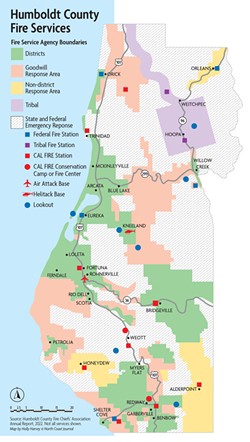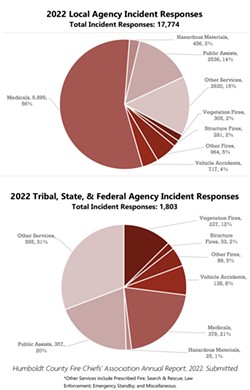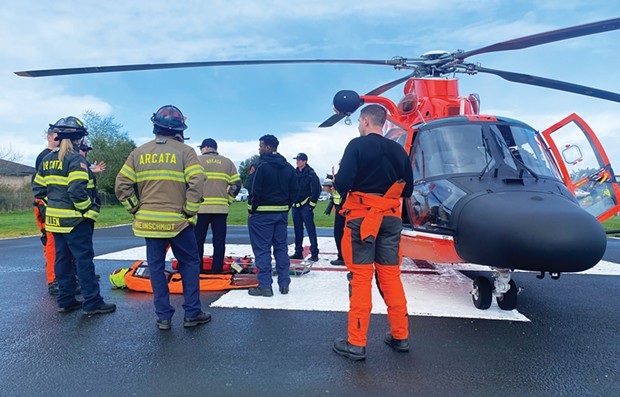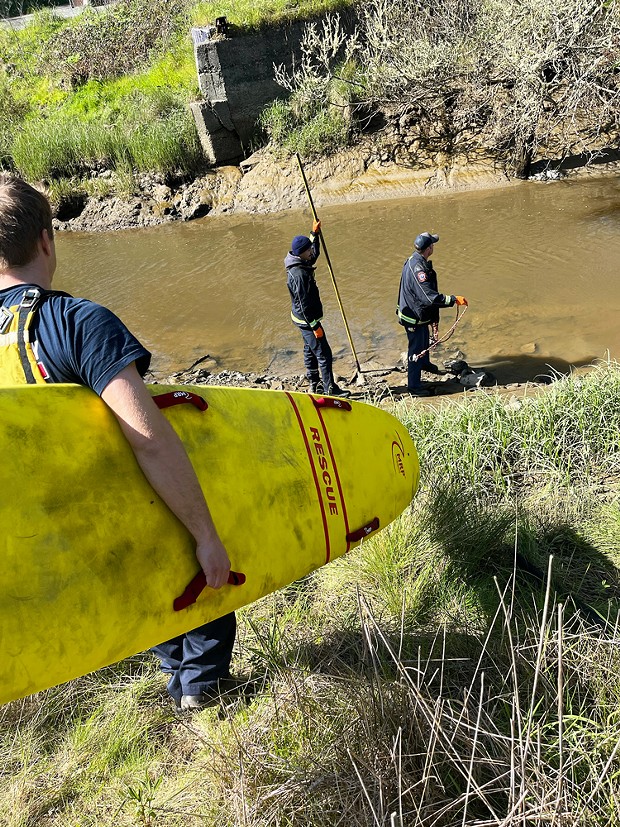Fire Alarm
Facing increased calls, soaring expenses and few volunteers, local fire departments are in trouble
By Thadeus Greenson [email protected] @ThadeusGreenson[
{
"name": "Top Stories Video Pair",
"insertPoint": "7",
"component": "17087298",
"parentWrapperClass": "fdn-ads-inline-content-block",
"requiredCountToDisplay": "1"
}
]
It's a sunny Monday morning and Humboldt Bay Fire Chief Sean Robertson and Fire Capt. Brandon Harlander are sitting in a nondescript conference room at the department's main station on C Street, talking to the Journal as a part of a media outreach campaign to spread the word about what they're describing as a "staffing crisis."
The department's Myrtle Avenue station has been closed for about six weeks, they say, explaining that three funded positions are currently sitting vacant because it's been difficult to recruit qualified candidates. Then, they say, they have four employees out on military or medical leave, creating temporary but long-term vacancies. This has left remaining firefighters working mandatory overtime and the department instituting what will be rotating closures of its stations based on daily staffing, creating up to three-minute delays in response times for some calls.
"We're just in a really challenging position we've never been in before," Robertson says.
He sighs, then continues, "Every department in the state seems to be hiring," noting that some nearby departments offer compensation packages $30,000 or more annually in excess of what Humboldt Bay Fire (HBF) is paying.
"We've lost 17 people in two years at every level," he says, noting that almost half those have moved north to the Arcata Fire Protection District, which saw voters pass a special assessment tax in 2020 to boost the department's funding, allowing it to offer firefighters better pay, including longevity bonuses that have successfully lured lateral transfers, including a handful from HBF. "We're losing a lot of experience."
Talking to the Journal a few days later, Arcata Fire Chief Justin McDonald, who will soon retire after a 30-year career, and Deputy Chief Chris Emmons, who is poised to take his place, concede things are looking much improved around Arcata, which not too long ago was also facing the reality of rotating station closures and the inability to retain staff.
"Sean's loss is our benefit," McDonald says, a bit sheepishly, if not apologetically. "We gained hundreds of years' worth of experience into our ranks, and everyone is local."
But they quickly note that 2020 tax sunsets in 2030 and Emmons already has "his marching orders" from the district's governing board to figure out a strategy for keeping the department funded and staffed.
Across the county, fire departments of all shapes and sizes report they are seeing increased calls of all types, from structure fires and medical aids to car crashes, amid increased difficulty recruiting both volunteer and paid firefighters. Meanwhile, expenses are spiking across the board, from the cost of diesel fuel and insurance to replacing and repairing old trucks and equipment.
Underscoring the precarious situation, just days after Robertson and Harlander pointed to Arcata Fire as their more affluent neighbor in discussing the need to keep up with the proverbial Joneses when it comes to firefighter compensation, the Humboldt County Civil Grand Jury issued its latest report of the year titled, "Dwindling Resources = Dwindling Services." In it, the grand jury warns that Arcata Fire currently can't afford the ladder truck needed to service the tall buildings currently planned or under construction within its district boundaries, while noting its funding is currently stagnant with an uncertain future.
"Due to inflation, the cost of providing existing services rises every year," the report states. "It will cost even more to pay for serving the district's growing population and its expanding and changing infrastructure. Funding levels are essentially static, so while costs rise, income for the district does not. The gap between increasing revenue and expense is widening."
Humboldt County Emergency Services Manager Ryan Derby says he's well aware of the challenges facing local fire departments, noting the soaring costs facing departments big and small, as well as both the shortage of professional firefighters and community members willing to volunteer. The situation, he says, poses serious concerns for the county's ability to respond to large-scale disasters. He points to the 2022 earthquake that caused widespread damage in Rio Dell, noting it was the Rio Dell Volunteer Fire Department that was the first to have personnel on scene, going door to door to help those in need.
"It's huge," Derby says. "We rely on fire departments, volunteer and full-time paid, for a lot of things. And when they're struggling in the day-to-day to keep up with call volume, it's much harder for us to have that quick, effective disaster response. I do worry about that."
'People Don't Volunteer Like They Used to'
Loleta Volunteer Fire Chief Jeff Robison has been a volunteer firefighter longer than he's done most other things in his life, having joined the department 40 years ago at the age of 21.
"It's near and dear to my heart," he says, noting that he would have started when he was younger but was forced to wait until he turned 21 "because there was beer in the station."
But, he says, the landscape is changing.
"We have been progressively increasing our number of calls per year, which is sort of scary at times because it's harder to get folks to volunteer for the department than before," Robison says. He explains that while the department once had a roster of more than 30 volunteers, it's dwindled to 14, with a core of eight to 10 who reliably respond. "I'm a member of the chiefs' association and we talk about this all the time. It's disheartening because nobody wants to make a commitment like that anymore."
This is a refrain echoed throughout the county, despite the fact that volunteers donated more than 102,000 hours to Humboldt County's three dozen fire departments in 2022, according to the annual fire chiefs association report, including almost 30,000 for training alone.
In Ferndale, Chief Rick Nicholson says his department has 26 volunteers, down from 40 to 45 about 15 years ago, when the department received 100 to 150 calls a year compared to the 300 or so it's currently averaging. Garberville Fire Protection District Chief Tim Tietz says he's got about 18 volunteers, down from more than 22, noting there was a time when the department had to "turn people away." The Phillipsville Volunteer Fire Co., meanwhile, has gone dormant after 50 years of service. Unable to recruit enough volunteers to respond to calls, Fire Chief Hank Toberg is working to keep its trucks minimally maintained, hoping they'll be in order if he can one day find the volunteers to operate them.
Chiefs offered a variety of reasons for the volunteer shortage, but the consensus seems to be that the job has become significantly more demanding with increased call volumes and mandated trainings, with the state having set nearly equal requirements for volunteers as their career counterparts. Loleta volunteers, for example, meet "every Wednesday night, every month of the year" to keep up with training demands, and that's after new volunteers have gone through the intensive Eel River Fire Academy.
Tietz says the down economy in Southern Humboldt has made recruiting volunteers especially challenging.
"Everyone has jobs — they have to work. There's just less money in the community," Tietz says, noting that the demand for professional firefighters throughout the state has also made it much easier for volunteers to vault into paid positions from the smaller departments that have typically provided a training ground, if not bypassing them altogether.
Derby says the decline in volunteerism isn't unique to firefighting, noting he's seeing it across the county.
"We're in a society that's more expensive to live in, and people are having to work later into their lives than maybe they planned," he says, adding that many in Humboldt County are working more than full time just to make ends meet.
The problem has become so pervasive some departments are looking at outside-the-box strategies. For example, the Fortuna Volunteer Fire Department, where the need has become so acute that the department has begun planning to hire more paid positions, Chief Rus Brown has begun rallying community support to offer incentives, like recruiting employers to pledge to pay employees even when called out to a fire response or landlords to offer reduced rent to volunteer firefighters, "anything that makes it a little easier to volunteer."
'Something Has to Give'
While the Humboldt County Civil Grand Jury's latest report focuses solely on Arcata, the dynamic it describes is not unique. Across the county, fire chiefs say they're trying to navigate a perfect storm of increasing calls and soaring costs with stagnant — and often uncertain — funding.
Nobody seems quite sure why, but every department contacted for this story reported that calls were up in 2023 over 2022 and have only increased in 2024.
"For some reason, they're just increasing," said Nicholson, adding that's true for calls of all types.
Tietz says when he started Garberville was fielding fewer than 100 calls a year while it now responds to 500.
And when a call comes in, departments have to respond, several chiefs said, noting there isn't the ability to triage the same way police can. Robertson, whose HBF responds to an astronomical average of 7,000 calls a year, says there are also times when calls come in simultaneously reporting a structure fire and a car accident, necessitating parallel responses.
Meanwhile, the costs of operation are similarly spiking. Tietz notes the cost of diesel fuel has doubled in the last few years, as have the department's insurance costs. Nicholson says Ferndale Fire's insurance costs spiked $30,000 last year alone. New state emissions standards and workplace safety requirements have added additional costs that local departments have to bear, Nicholson says.
Equipment costs have also skyrocketed, chiefs say.
In a presentation to the Fortuna City Council earlier this year, Fire Chief Rus Brown said that back in 2020 his department projected replacement costs for two fire engines approaching the end of their lifespans at $400,000 apiece, while four years later that price has leapt to $900,000 each.
And departments have limited ability to adjust revenue models accordingly. Local fire departments take a variety of forms with a corresponding variety of funding mechanisms, with most scraping by on a mix of property tax apportionments, special assessments and grants. Generally, these funding streams are locked in at a stagnant rate that only changes when a tax or assessment sunsets and comes off the books, or is renewed by voters at an elevated rate.
Arcata Fire, for example, has three main sources of revenue. Approximately 40 percent of its budget comes from per-parcel county property tax allocations based on the number of parcels within its district, which remains stagnant year to year. The balance of the department's revenue comes in through a benefit assessment tax passed by voters in 2006 — a set per-property fee that sees homeowners pay $88 a year annually — and the previously mentioned special tax measure, which will stay stagnant until it expires in 2030.
Garberville Fire, meanwhile, depends on its property tax apportionment, a special parcel tax passed last year, an annual community fundraiser and fees earned by aiding CalFire's wildfire responses to make ends meet. Tietz says things are looking up, thanks to the tax measure and the recent annexation of land south through Benbow to the county line, but times have been rough.
"We were struggling to pay our bills for a while," he says. "And that sucks when you have to fundraise to pay your fuel bill."
Measure Z, the countywide 0.5 percent sales tax passed in 2014 after a campaign pledging it would go to enhancing public safety services, has been hugely helpful, chiefs say, noting it's helped departments replace safety equipment, trucks and training apparatuses. But as tax revenue has dipped along with the economy, and as ongoing expenses it has pledged to cover in the form of salaried positions in the sheriff's office and other departments continue to rise, there's no longer much left for fire departments.
When it comes to recurring annual funds, Nicholson said his department is still working with "revenues from the mid '90s or early 2000s, and that doesn't stretch in 2024."
Even from one of the plusher seats in the world of local fire departments, the landscape appears daunting.
"Call volumes are only going up," says Emmons. "They're not dropping. The fire industry in Humboldt County is absolutely getting busier. And if the funding is staying flat and things are getting busier, something has to give."
'A Lot of Challenges'
Back at Humboldt Bay Fire, Robertson is hopeful. The department — the product of a consolidation of the Humboldt Bay Fire District and the city of Eureka's municipal department — is governed by a joint powers authority, which recently passed a new memorandum of understanding to significantly increase compensation. The increase gives firefighters a 6-percent raise across the board, to be followed by another 1.5-percent spike next year, with added increases for captains and engineers, and tiered longevity raises.
The new deal undeniably makes the department's pay scale more competitive locally, which Robertson hopes will ease its recruitment and retention struggles and get it back on track toward full staffing. But for how long in an industry experiencing a statewide arms race for professional firefighters remains an open question.
Throughout the county, departments are struggling to find answers.
After the Tubbs Fire in 2017 caused an estimated $1.2 billion in losses in Santa Rosa alone, Sonoma County revamped its approach to fire districts. Through a concerted effort, the county saw its 43 fire departments consolidate into 23 in an effort to create economies of scale, with the county also pledging a number of ongoing funding sources, including a portion of its transient occupancy tax revenue and a special 0.5 percent sales tax passed in March to exclusively fund fire prevention and disaster response.
Some point to Sonoma as a possible model, though it would be a complicated road.
Tietz says the process of Garberville annexing the district boundaries to its south took seven years of work and negotiations, including hundreds of hours of meetings. That's a heavy lift for a department already struggling to fulfill its day-to-day duties.
One fire chief interviewed for this story referred to consolidation as the "dirty little turd in the room," noting it's an arduous and complicated process, and one that necessitates relinquishing local control.
Some have suggested departments that serve areas along Avenue of the Giants — including Phillipsville, Myers Flat, Miranda and Fruitland Ridge — consolidate into an Avenue Fire District, though the idea doesn't seem to have gotten much traction to date.
Speaking generally about the topic of consolidation, Nicholson says, "On paper, it's simple. Pulling it off in real life, there's a lot of challenges."
Derby, for his part, says consolidation may bring benefits but quickly adds that it seems unlikely to generate more volunteers or applicants for firefighting positions. And while some would like to see a countywide tax measure that would solely fund fire services put before voters, most concede it would be a hard sell to voters, who are already facing stretched household budgets and are already slated to see a variety of tax measures on their ballots this November.
The reality, most chiefs say, is departments will likely have to continue to scrap things together and help each other.
McDonald says that while most agencies on the North Coast used to be able to handle a residential structure fire on their own, they now coordinate mutual aid responses from multiple agencies.
"We totally depend on our volunteer neighbors and we return the favor," he says, adding that such collaborative responses will likely increase.
And even if residents don't have the time or physical ability to sign up as a local volunteer firefighter, there are a host of things they can do to help departments continue to respond to emergency calls. Nicholson urges people to shop local, noting it boosts sales tax revenue — including Measure Z — that can go to support local services. Others stress that just because someone can't lift a hose or donate out of pocket doesn't mean they can't help organize a fundraiser, volunteer to fill an administrative role or otherwise lend their department a helping hand. Robison encourages folks to talk to their supervisors and elected officials to advocate for local fire services.
And sitting in that conference room on C Street, Harlander says those who are physically able should consider a career in fire.
"For me, it's the best job in the world," he says, recounting how it's allowed him to do everything from saving a tortoise from a structure fire to helping a local elder with their smoke alarm. "It's a great career. Every day is different."
Thadeus Greenson (he/him) is the Journal's news editor. Reach him at (707) 442-1400, extension 321, or [email protected].
more from the author
-
Court Rejects Zoellner Appeal
- Jun 28, 2024
-
Journal Welcomes California Local News Fellows
- Jun 27, 2024
-
Change of Plea Hearing Set in Fair Embezzlement Case
- Jun 27, 2024
- More »
Latest in News
Readers also liked…
-
Through Mark Larson's Lens
A local photographer's favorite images of 2022 in Humboldt
- Jan 5, 2023
-
'To Celebrate Our Sovereignty'
Yurok Tribe to host gathering honoring 'ultimate river warrior' on the anniversary of the U.S. Supreme Court ruling that changed everything
- Jun 8, 2023




































